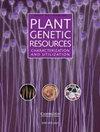利用重组Indra自交系和新植物遗传资源ac39416a定位水稻抗洪性状qtl
IF 0.7
4区 生物学
Q3 PLANT SCIENCES
Plant Genetic Resources: Characterization and Utilization
Pub Date : 2023-03-22
DOI:10.1017/s147926212300014x
引用次数: 0
摘要
水稻作物在作物周期的不同阶段受到不同类型洪水的影响。经过研究人员的不懈努力,通过传统育种和分子育种方法,开发出了适合厌氧萌发、山洪暴发和滞洪的水稻品种。为应对气候变化的不利影响,需要在新的遗传源(AC39416A)中检测不同类型洪水的qtl。本研究利用Indra和AC39416A的重组自交系进行了抗洪性qtl的鉴定。QTL定位鉴定出3号染色体上的qAG3.1与厌氧萌发有关,10号染色体上的qSF10.1与滞水条件下植物存活率有关。这些qtl分别解释了59.08和13.21%的表型变异。在qAG3.1区域鉴定出两个候选基因,LOC_Os03g42130赤霉素20氧化酶2和LOC_Os03g44170谷胱甘肽s转移酶。其潜在机制可能是抑制赤霉素酸的合成,从而保护幼苗免受缺氧条件下的氧化应激。qSF10.1基因组区发现LOC_Os10g35020糖基转移酶位点和LOC_Os10g35050水通道蛋白位点,可能与植物滞涝生存的适应机制有关。这说明新遗传资源AC39416A对环境胁迫具有不同类型的抗洪能力。利用先进的组学研究揭示AC39416A耐洪水的生理和分子机制,将有助于在洪水易发地区进行精确的基因组选择,以实现持续生产。本文章由计算机程序翻译,如有差异,请以英文原文为准。
Mapping of QTLs for flood tolerance in rice using recombinant inbred lines of Indra and a new plant genetic resource AC 39416 A
Rice crop is affected by different types of floods at different stages of the crop cycle. Constant efforts of researchers resulted in the development of rice varieties for anaerobic germination, flash floods and stagnant flooding by both conventional and molecular breeding approaches. Detection of QTLs for different types of floods in new genetic source (AC39416A) is needed to combat adverse effects of climate change. Present investigation was carried out to identify QTLs for flood tolerance using recombinant inbred lines derived from Indra and AC39416A. QTL mapping resulted in identification of QTLs, qAG3.1 on chromosome 3 for anaerobic germination and qSF10.1 on chromosome 10 for plant survival % under stagnant flooding. These QTLs explain 59.08 and 13.21% of phenotypic variance respectively. Two candidate genes were identified in qAG3.1 region, LOC_Os03g42130 gibberellin 20 oxidase2 and LOC_Os03g44170 glutathione S-transferase. The underlying mechanism might be the inhibition of gibberellic acid synthesis and thereby protecting seedlings from oxidative stress under anoxia condition. Genomic region of qSF10.1 revealed LOC_Os10g35020 glycosyltransferase and LOC_Os10g35050 aquaporin protein loci, which might be responsible for adaptive mechanism for plant survival % under stagnant flooding. This indicates that the new genetic resource AC39416A has an ability to adopt to different types of flood tolerance in response to environmental stress. Unveiling physiological and molecular mechanisms for flood tolerance in AC39416A using advanced omics studies would help in precise genomic selections for sustained production in flood-prone areas.
求助全文
通过发布文献求助,成功后即可免费获取论文全文。
去求助
来源期刊

Plant Genetic Resources: Characterization and Utilization
Agricultural and Biological Sciences-Agronomy and Crop Science
CiteScore
2.80
自引率
0.00%
发文量
29
审稿时长
>12 weeks
期刊介绍:
Plant Genetic Resources is an international journal which provides a forum for describing the application of novel genomic technologies, as well as their integration with established techniques, towards the understanding of the genetic variation captured in both in situ and ex situ collections of crop and non-crop plants; and for the airing of wider issues relevant to plant germplasm conservation and utilisation. We particularly welcome multi-disciplinary approaches that incorporate both a technical and a socio-economic focus. Technical aspects can cover developments in technologies of potential or demonstrated relevance to the analysis of variation and diversity at the phenotypic and genotypic levels.
 求助内容:
求助内容: 应助结果提醒方式:
应助结果提醒方式:


